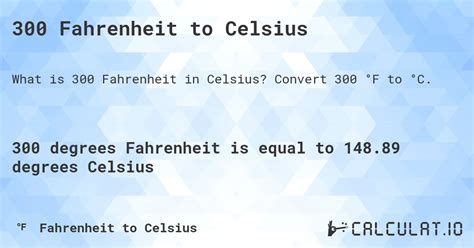What Is 300 F In C
Kalali
Apr 03, 2025 · 4 min read

Table of Contents
What is 300°F in Celsius? A Comprehensive Guide to Temperature Conversions
Converting between Fahrenheit (°F) and Celsius (°C) is a common task for many, whether you're checking a recipe, understanding weather forecasts, or working with scientific data. This comprehensive guide will delve into the conversion of 300°F to Celsius, explaining the process, providing the answer, and exploring various applications and related temperature concepts.
Understanding Fahrenheit and Celsius
Before diving into the conversion, let's briefly review the two temperature scales:
-
Fahrenheit (°F): This scale, developed by Daniel Gabriel Fahrenheit in the early 18th century, sets the freezing point of water at 32°F and the boiling point at 212°F, at standard atmospheric pressure. It's primarily used in the United States and a few other countries.
-
Celsius (°C): Also known as the centigrade scale, Celsius was developed by Anders Celsius in the 18th century. It sets the freezing point of water at 0°C and the boiling point at 100°C, again at standard atmospheric pressure. It's the most widely used temperature scale globally.
Converting 300°F to Celsius: The Formula
The conversion between Fahrenheit and Celsius is straightforward using a specific formula. The formula to convert Fahrenheit to Celsius is:
°C = (°F - 32) × 5/9
Let's apply this formula to convert 300°F:
°C = (300 - 32) × 5/9
°C = 268 × 5/9
°C = 148.89°C (approximately)
Therefore, 300°F is approximately equal to 148.89°C.
Practical Applications of 300°F (148.89°C)
Understanding what 148.89°C represents in real-world scenarios is crucial. This temperature range falls within several practical applications:
1. Cooking and Baking:
-
Baking: Many oven recipes call for temperatures around 300°F (148.89°C). This temperature is ideal for baking various items, including cookies, cakes, and some types of bread, ensuring even cooking and a desirable texture. The precise temperature will depend on the recipe and desired outcome.
-
Roasting: Roasting meats and vegetables often involves temperatures around 300°F (148.89°C), leading to browning and creating a crispy exterior while maintaining moisture inside.
2. Industrial Processes:
Many industrial processes utilize temperatures in this range. Examples include:
-
Heat treating of metals: Certain heat treatment processes require precise temperature control around 300°F (148.89°C) to alter the properties of metals, enhancing their strength or durability.
-
Plastics processing: Some plastics are processed at temperatures around 300°F (148.89°C) during molding or extrusion.
3. Scientific Experiments and Research:
In scientific settings, precise temperature control is often crucial. Experiments involving chemical reactions, material science, or biological processes might require maintaining a constant temperature near 300°F (148.89°C).
4. Everyday Life:
While less common than lower temperatures, instances where you might encounter this range include:
-
Saunas: Some saunas can reach temperatures approaching 300°F (148.89°C), although this is at the higher end of typical sauna temperatures. Caution: Always adhere to safety guidelines when using saunas.
-
High-temperature cleaning: Some industrial or specialized cleaning processes might involve temperatures in this range.
Understanding Temperature Measurement and Accuracy
It's essential to understand the accuracy and limitations of temperature measurements. The precision of the measurement depends on the instrument used (thermometer, thermocouple, etc.) and the environment.
-
Calibration: Temperature measuring devices require periodic calibration to ensure accuracy. A poorly calibrated device can lead to inaccurate readings.
-
Environmental Factors: Factors such as air currents or heat sources nearby can affect the accuracy of a temperature reading.
Related Temperature Conversions
While we've focused on converting 300°F to Celsius, understanding related conversions is also beneficial. Here's a brief overview:
-
Celsius to Fahrenheit: The reverse conversion uses the formula: °F = (°C × 9/5) + 32
-
Kelvin: Kelvin (K) is the absolute temperature scale, where 0K represents absolute zero. The conversion from Celsius to Kelvin is: K = °C + 273.15
-
Rankine: Rankine (°R) is another absolute temperature scale used primarily in some engineering fields. The conversion from Fahrenheit to Rankine is: °R = °F + 459.67
Advanced Temperature Concepts
Beyond basic conversions, understanding advanced temperature concepts will deepen your knowledge:
-
Heat Transfer: Heat transfers from higher temperature objects to lower temperature objects until thermal equilibrium is reached. This transfer can occur through conduction, convection, or radiation.
-
Thermal Expansion: Materials generally expand when heated and contract when cooled. This property has significant implications in engineering and design.
-
Specific Heat Capacity: This measures the amount of heat required to raise the temperature of a substance by a certain degree.
-
Latent Heat: This refers to the energy absorbed or released during phase transitions (e.g., melting, boiling).
Conclusion: Mastering Temperature Conversions
Converting 300°F to Celsius, resulting in approximately 148.89°C, is a straightforward process using the provided formula. However, this simple calculation opens doors to understanding the vast applications of temperature in cooking, industry, science, and everyday life. By grasping the underlying principles and related concepts, you'll develop a more profound understanding of temperature and its significance in our world. Remembering the formula and its application is key, but understanding the broader implications elevates your knowledge beyond a simple numerical answer. Accurate temperature measurement is critical, and recognizing the potential for inaccuracies due to calibration and environmental factors allows for a more nuanced understanding of temperature data.
Latest Posts
Latest Posts
-
How Many Meters Are In 11 Feet
Apr 04, 2025
-
How Many Feet In 30 Meters
Apr 04, 2025
-
8 Quarts Is How Many Cups
Apr 04, 2025
-
How To Mix Battery Acid And Distilled Water
Apr 04, 2025
-
How Many Cups In 60 Ounces
Apr 04, 2025
Related Post
Thank you for visiting our website which covers about What Is 300 F In C . We hope the information provided has been useful to you. Feel free to contact us if you have any questions or need further assistance. See you next time and don't miss to bookmark.
